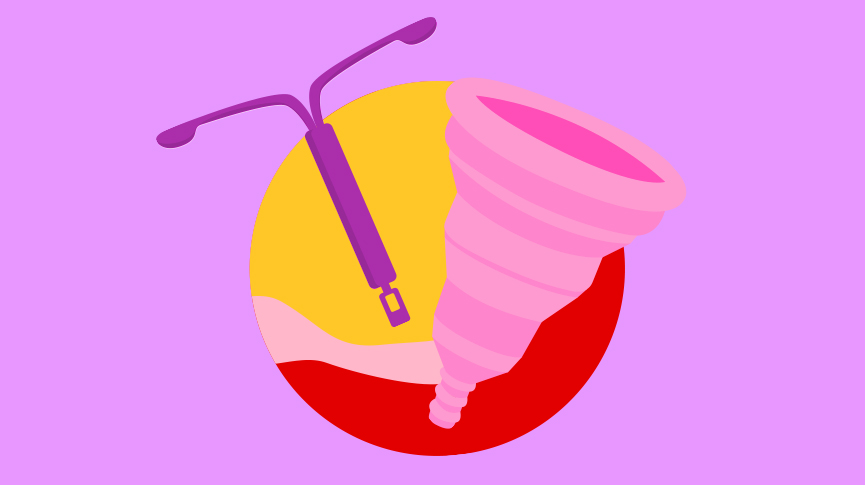Using a Menstrual Cup and IUD Together: What You Need to Know

This article was medically fact-checked by Consultant Obstetrician and Gynaecologist Dr. Shree Datta.
Can you use a menstrual cup if you have an intrauterine device (IUD), otherwise known as a “coil”? The short answer: yes! While you should always discuss your specific situation with your physician, in most cases you just have to be a little more aware of your body and the devices you’re using.
Keep in mind, that this advice is valid for people with both the copper IUD or a hormonal one.
Here’s the essential guide to making sure that your cup and your IUD peacefully coexist.
Where do they go?
An IUD (or coil) goes inside your uterus to help prevent pregnancy, while a menstrual cup sits in your vagina to collect your menstrual flow. These two body parts are separated by the cervix (get the lowdown on female anatomy here). The removal threads of the IUD hang down through the cervix and should sit right at the top of your vagina.
A menstrual cup, on the other hand, is worn lower down in the vagina, so they shouldn’t interfere with each other during use.
There is always some risk of an IUD becoming expelled or dislodged, but a 2011 study of 900 women in Canada showed that the use of menstrual cups or tampons during menstruation in no way increased the risk of early expulsion of an IUD.
However, you do need to be aware of your IUD strings and be careful during insertion and removal of your cup. Here are a few tips to help you:
Give your IUD time to settle.
Give your IUD two menstrual cycles to settle into place before using a menstrual cup or tampons. If it is going to happen, the IUD would most likely become dislodged in the two months after insertion, especially during menstruation.
Once your IUD is happily in place you can start to use your menstrual cup.
Know where your strings are.
When you have an IUD you should regularly check the strings to make sure it hasn’t moved or come out of your uterus. If the strings are too long you may want to ask your gynaecologist to trim them down a bit so they stay out of the way.
When inserting your cup, if you have a low cervix (we talk about this in the next section), make sure the strings are inside the cup and not between it and your vaginal wall.
Do a coil thread check when you are not on your period to reduce the risk of infection and discomfort. It can also be a bit messy to check while on your period, but can still definitely work.
Things to watch for with a coil include a change in the colour, consistency and smell of vaginal discharge. If this occurs, make sure you get checked over by a Gynaecologist first before using any period products during your next period.
Every time you remove your menstrual cup, just check that your strings are in the same place. You can slide your finger up the side of the cup and run it around the rim to ensure that the strings aren’t stuck between the cup and the wall.
Take note of where your cervix is.
Depending on where your cervix is positioned during your period, you may want to choose a shorter cup that will sit lower, away from your cervix and the strings of your IUD. There are many cups that are designed to be shorter or can even be trimmed to shorten the stem.
It may mean that the cup will have a slightly lower capacity, but it also means you can worry less about your strings! Not sure where your cervix is? Here’s an easy way to find out.
Your cervix can change position (height) throughout your cycle, so it’s best to check it during menstruation since that’s when you’ll be using the cup. Or you can ask your doctor when she inserts or checks your IUD.
Release the suction.
You should always release the seal before removing a cup, but it’s especially important to do this when you have an IUD. After you’ve checked your strings, just squeeze the base of the cup or reach up and press on the rim to release the seal and prevent any suction as you take it out.
So now you know! You can have the best of both worlds when it comes to your intimate health.
An IUD is one of the most reliable forms of birth control and menstrual cups take all the hassle out of periods. Using them together just requires a little more awareness and practice, but is totally worth it to make maintaining your intimate health super easy and convenient.
Facts checked by:
Dr. Shree Datta
Dr. Shree Datta is a Consultant Obstetrician and Gynaecologist in London, specialising in women’s health including all menstrual problems such as fibroids and endometriosis. Dr. Shree is a keen advocate for patient choice, having written numerous articles and books to promote patient and clinician information. Her vision resonates with INTIMINA, with the common goals of demystifying periods and delivering the best possible care to her patients
Written by:

A collective group of “lady experts” at Intimina who love sharing our personal experiences, even when they are a little too personal. We believe it’s time to start breaking down the taboos around menstruation, motherhood, and menopause, and start owning our female health.




And what about the Ziggy Cup? Is the same orientation?
Hi Nayara,
it would be best to advise your doctor about this question.
Best regards